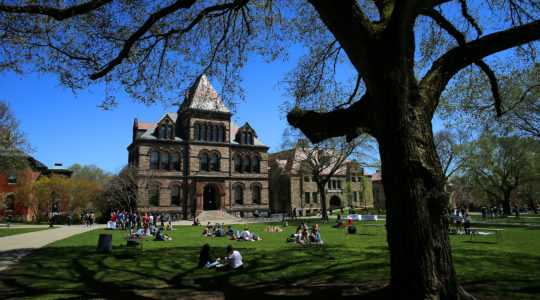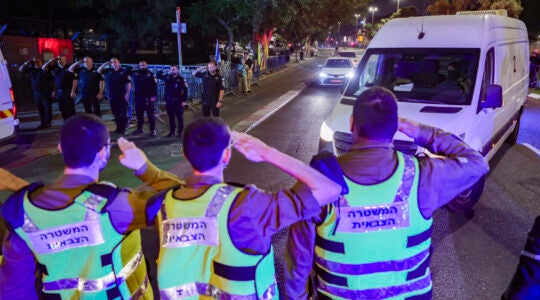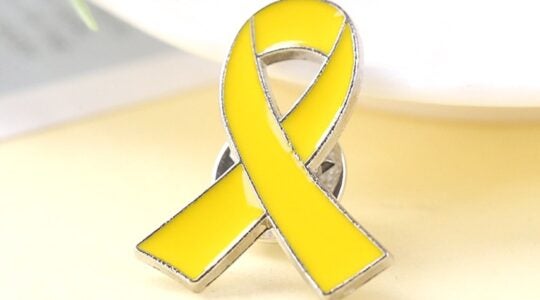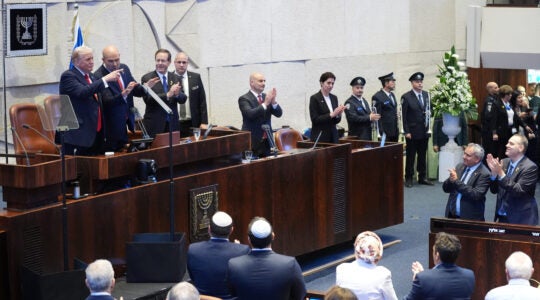SEATTLE (Jewish Transcript Publications) – Jurors had to be removed from a Seattle courtroom Thursday when a witness in the trial of the July 2006 shooting at the Jewish Federation of Greater Seattle broke down in tears.
Christina Rexroad broke down in tears on the stand, and the jury had to be removed until she composed herself. Rexroad was injured during the shooting and was almost dead when she was taken to the hospital that day.
Thursday was not the first time there were wet eyes in the courtroom.
Many jurors and spectators at the court were moved to tears Monday as they listened to the quivering voice of 14-year-old Kelsey Burkum, niece of shooting victim Cheryl Stumbo, tell 911 operators and police how Naveed Haq pulled a gun on her and forced his way into the federation building.
The high school sophomore, now 16, was soft-spoken while on the witness stand.
Once inside the building, she told the court, Haq turned his attention to the receptionist, and asked to see the manager. As Burkum ducked into the women’s bathroom to hide, the teen recalled hearing “shots and screaming” and someone yelling, “call 911!”
Minutes later, after several other calls had gone in to emergency personnel from other victims cornered by Haq in their offices, or in the federation’s hallway, during the shooting spree, the 30-year-old Muslim-American man was in custody.
One woman, Pamela Waechter, 58, was killed and five others were seriously wounded, including Stumbo, Burkum’s aunt.
Officers who rescued the young girl brought her to a hospital to be checked out, but she was not injured.
During their opening statements, defense lawyers argued that Haq, a diagnosed schizophrenic who also has bipolar disorder and a 10-year history of mental problems, was angry, agitated, and “unable to appreciate the nature of his acts that day.”
Detailing Haq’s medical records by showing the treatment that Haq had received for mental health problems during the six months leading up to the shootings, defense attorney John Carpenter told the court that Haq was at the time becoming increasingly angry, and had seen a doctor 12 times to discuss his growing rage.
The physician’s notes documented Haq’s consistent and recurring therapeutic goal: “To be less angry,” Carpenter said.
Haq’s defense will focus on the drug Effexor, an anti-psychotic medication prescribed to Haq when he was taken off of lithium, a more conventional treatment considered to be the “gold standard,” added Carpenter.
Carpenter also told the court that the Food and Drug Administration includes a caution on the Effexor warning label, stating that it has been shown to produce homicidal effects in 2 to 5 percent of the population that uses it. He inferred that Haq was a part of that minority.
Prosecutors painted another picture of the defendant, however. They say Haq was deliberate, calm, controlled and calculating that day.
According to Erin Ehlert, one of King County’s senior deputy prosecuting attorneys, Haq had the presence of mind right before the shooting to give an officer who cited him for a routine traffic violation his name and updated address information on the back of his driver’s license, without triggering any suspicion.
Burkum, who took the stand late Monday morning, testified that Haq had calmly instructed her to be “careful” as she waited to be admitted to the building by the federation’s receptionist. Ehlert told the courtroom that Haq had stood out of the way of security cameras while they waited.
Following her niece, Stumbo, the director of marketing and communications for the federation, testified that Haq had “seemed angry, but his tone didn’t show it. He was not shouting, not screaming…he was pointing the gun at me.”
Two more federation employees who were shot – Layla Bush, the receptionist, and Carol Goldman, a coordinator for the community campaign – took the stand Wednesday and gave their accounts of the shooting.
Bush, 24, testified that she had been unable to move off the floor to perform what she saw as her primary task at that moment: to call 911. Goldman, during her testimony, moved her chair to the middle of the courtroom to demonstrate to the jury the angle from which Haq shot her in the leg.
Several supporters and employees of the federation have sat in the small courtroom since the trial began. Many became tearful during Monday’s opening statements, when prosecutor Ehlert made her most dramatic point: She recreated the image of Haq, extending his arm over the stairwell railing and taking aim, then shooting Pamela Waechter for the second time as she tried to flee, inflicting a fatal wound to her brain through her left ear.
Once in custody, added Ehlert, “the defendant followed every single direction.”
The evidence seized by detectives from Haq’s apartment in Pasco, in eastern Washington, showed that he had planned the crimes during the 12-day period leading up to July 28. Haq had allegedly conducted a Google search of Jewish sites in Seattle that yielded the federation’s address. He had also retrieved directions to the building.
“He thought out what he did,” Ehlert said. “He planned what he did. He acted intentionally.”
Other documents in Haq’s home showed that he bought two guns during those 12 days, filling out the necessary paperwork for one and making a $100 deposit on another, according to charging papers.
Federal law prohibits people with serious mental health histories from buying guns. However, Washington state law allows individuals who are detained for certain short-term mental health evaluations and commitments to buy firearms.
In addition to the guns, Haq bought “hollow-point ammunition,” bullets that explode in the front when they come into contact with an object, Ehlert said.
Ilana Kennedy, the director of education for the Washington State Holocaust Education Resource Center, a Jewish organization located directly under the federation’s offices, testified that she heard screams and loud thuds above her that sounded like furniture being moved. She soon realized it was the sound of people hitting the floor.
“I heard probably nine shots and the screaming continued the entire time,” said Kennedy, who added that she could still hear screaming from the building after she made her way out of the building and onto the street.
JTA has documented Jewish history in real-time for over a century. Keep our journalism strong by joining us in supporting independent, award-winning reporting.





